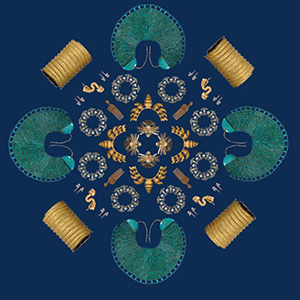
The Metropolitan Museum of Art announced this week it will debut an exhibition on Nov. 12 designed to “traverse time and space to explore how jewelry acts upon and activates the body it adorns.”
Jewelry: The Body Transformed explores the power and purpose of jewelry through roughly 230 objects—culled almost exclusively from The Met’s existing collection.
Expect to see headdresses, ear ornaments, brooches, belts, necklaces, and rings made between 2600 B.C.E. and the present day, alongside sculptures, paintings, prints, and photographs mean to “enrich and amplify the many stories of transformation that jewelry tells,” according to a statement on the show from the museum.
“Great jewelry from around the world will be presented in a radiant display that groups these ornaments according to the part of the body they adorn: head and hair; nose, lips, and ears; neck and chest; arms and hands; and waist, ankles, and feet,” reads the release.
Several galleries will be organized thematically: The Divine Body will examine an early conception of jewelry—its link to immortality—and will feature a head-to-toe ensemble from ancient Egypt expressly created to travel with illustrious citizens into the afterlife. Here also will be items from the Royal Cemetery of Ur, which was “implicated in one of the most mysterious rituals of ancient Mesopotamia,” according to the statement.
The Regal Body will examine the ways in which jewelry has asserted rank and status throughout history, and will feature sapphires and pearls from Byzantium, “finely wrought gold from the elites of Hellenistic Greece,” and ivory and bronze from the royal courts of Benin.
The Transcendent Body will focus on how jewelry has been used to “conjure spirits, appease gods, and evoke ancestors,” according to the statement. Look for jewelry from India that illustrates Hindu religious practices and adornments from Coastal New Guinea, made from shell and feathers, that “speak to jewelry’s capacity to channel the spiritual well-being of the wearer.”
The Alluring Body gallery is curated to explore “how jewelry engenders desire.” Here you’ll find woodblock prints and period hair ornaments from Edo Japan, photographs and jewels that spotlight the eroticism of pearls in the Victorian era, and jewelry from Elsa Schiaparelli, Art Smith, Elsa Peretti, and Shaun Leane that’s meant to document “how designers push the limits of glamour, courting danger and even pain.”
Lastly, The Resplendent Body will “call out the marriage of material and technique for the purpose of ostentation,” according to the release. Expect to see jewelry from the Mughals, “the aesthetic of accumulation in the gold and silver jewelry of the Akan and Fon peoples of West Africa,” and designs from iconic jewelry houses including Tiffany, Castellani, and Lalique.
A series of education programs will be offered alongside the exhibition, and an illustrated catalog featuring essays by Met curators from across the Museum ($50) will be available in the Met Store.
Top photo: Pieces from the forthcoming Met exhibit “Jewelry: The Body Transformed” Outside to center: Broad Collar of Wah, Egyptian, ca. 1981.1975 B.C. (40.3.2); Bracelet with Crocodile Heads, Edo peoples (Court of Benin, Nigeria), 17th–19th century (1991.17.80); Yves Saint Laurent (French, born Algeria), Earrings,1983–84 (2009.300.2224a, b); Serpent Labret with Articulated Tongue, Aztec (Central Mexico), 1300–1521 (2016.64); René-Jules Lalique (French, 1860–1945), Necklace, ca. 1897–99 (1985.114); Comb with Rooster, Baule peoples (central Côte d’Ivoire), 19th–20th century (1980.430); Necklace with Leaf-Shaped Pendants, Javanese, second half of the 9th–first quarter of the 10th century (1998.544.11a-i); Headdress Ornament, Calima-Yotoco (Colombia), 1st–7th century (66.196.24). © The Metropolitan Museum of Art, New York
- Subscribe to the JCK News Daily
- Subscribe to the JCK Special Report
- Follow JCK on Instagram: @jckmagazine
- Follow JCK on X: @jckmagazine
- Follow JCK on Facebook: @jckmagazine